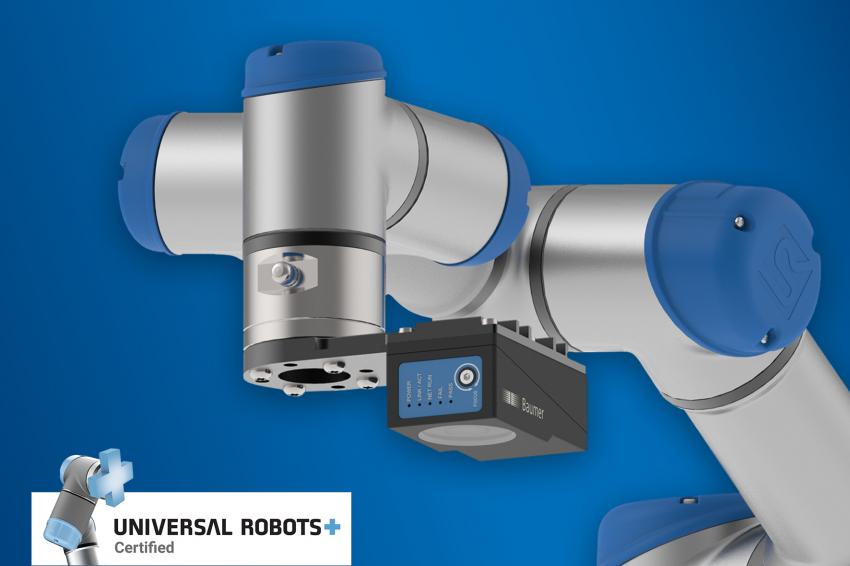Baumer: Robot-compatible Vision Sensors VeriSens XF900 and XC900
Nominee inspect award 2021
The robot-compatible vision sensors VeriSens XF900 and XC900 enable automated coordinate alignment with Universal Robots without the usually required manual "hand-eye calibration." This is based on the intelligent Baumer bit pattern SmartGrid (patent pending) which is hidden in the standard checkerboard format. A section of the SmartGrid is sufficient for the vision sensor to determine its position. As the cobot always knows its own coordinates, a limited number of linear and rotation movements are enough to automatically align the coordination systems. In addition, VeriSens uses the SmartGrid as the basis for distance-dependent scaling of coordinates, image distortion correction and conversion to world coordinates.
Image processing is the key to effectively extend robot functionalities. Robots with these capabilities can grip freely placed objects beyond fixed waypoints, as they determine their position coordinates with the help of vision sensors. But there is much more to this technology, such as checking out available storage space and gripper clearance as well as identifying any overlapping objects. Even sorting according to quality or identification features such as codes is easily solved with robots.
However, image processing is only a benefit when being mastered by many users. VeriSens vision sensors are the ideal solution, as they offer a complete image processing system in a compact housing. The robot-compatible VeriSens XF900 and XC900 integrate into Universal Robots via the VeriSens URCap interface. Just two additional commands (nodes) open access to multi-faceted options of image processing and 21 high-performance feature checks. The image processing task itself is parameterized completely and as usual via the VeriSens Application Suite – independent from cobot and in the environment best suited for this purpose.
The functions of the VeriSens URCap are generic and thus address all conceivable applications, including the integrated or stationary arrangement of the vision sensor. This means high transparency and easy operation for everyone. However, a major challenge is that cobot and vision sensor operate in their own coordinate systems. Most products solve this by manual "hand-eye calibration" which follows a strict scheme of all-manual steps. This process is often time-consuming and error-prone. With the SmartGrid (patent pending), Baumer follows an innovative path for automated calibration of VeriSens vision sensors – a quantum leap in coordination alignment. For the first time, automated calibration is possible and cuts robot setup times down to a few minutes at even more precise calibration. The highlight is the intelligent bit pattern hidden in the usual chessboard format. It provides valuable additional information that VeriSens® as an intelligent image processing sensor is able to read. One of this information is the position of the vision sensor above the pattern. With the cobot always knowing its own coordinates, intelligent algorithms and few moves suffice for automated coordination alignment. This process is not only extremely precise and free from manual errors – it is easily done straight on the cobot’s touchscreen.
In terms of coordinates, this solves the problem of finding objects. However, SmartGrid allows for much more: VeriSens sensor use the grid for learning the ideal image. The vision sensors can then rectify captured images in real time to correct lens distortions, for example. As the bit pattern also provides data regarding size from the respective SmartGrid used, the VeriSens now has all information required for scaling. This way, conversion into global coordinates is automatically set. SmartGrid additionally supports semi-automatic Z calibration, allowing VeriSens to learn its 3D position and to apply the image correction data also in a 3D manner. This way, the final challenge in vision-guided robotics is solved: The 2D visions sensor has to provide data to a 3D robot. It would not be very user friendly if only the coordinates of a single level, the image level, could be used. A robot in particular also requires coordinates of other levels of the Z axis, e.g., for grabber access or for the detection of important markings. Z calibration makes the automatic alignment of the coordinates to other "heights" possible.
This innovative approach in automated coordinate alignment, automated image correction in real time, conversion to global coordinates and Z calibration make vision-guided robotics easily accessible to many users.
Vote at www.inspect-award.com and choose the best machine vision product. Three Amazon vouchers worth 50 euros each will be raffled among all participants.
Contact
Baumer Group
Hummelstraße 17
8501 Frauenfeld
Switzerland
+41 52 728 1122
+41 52 728 11 44







